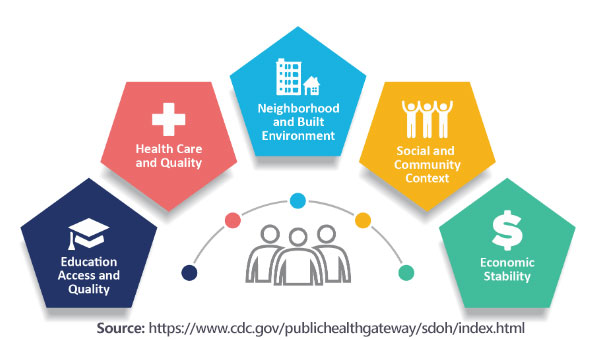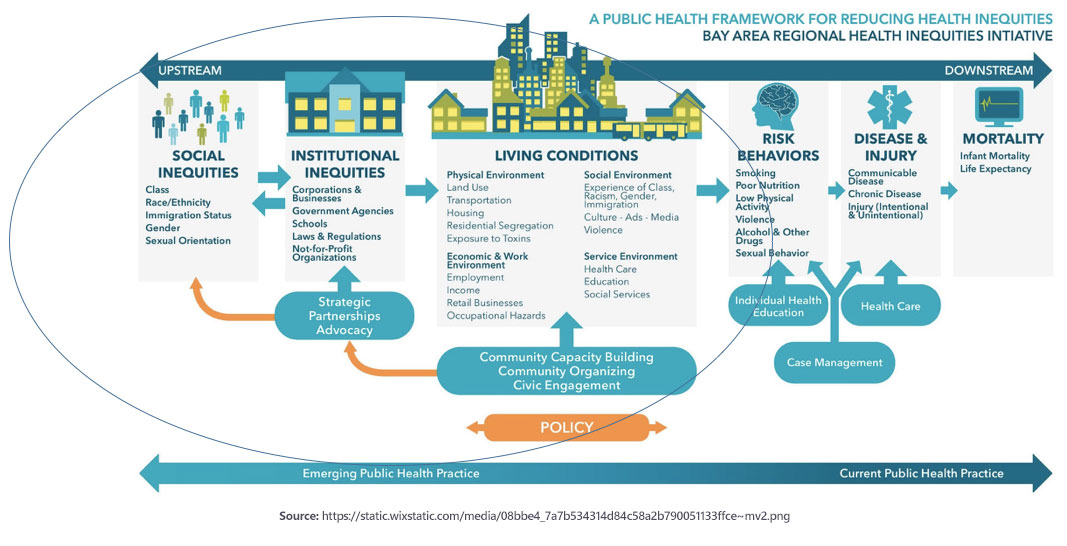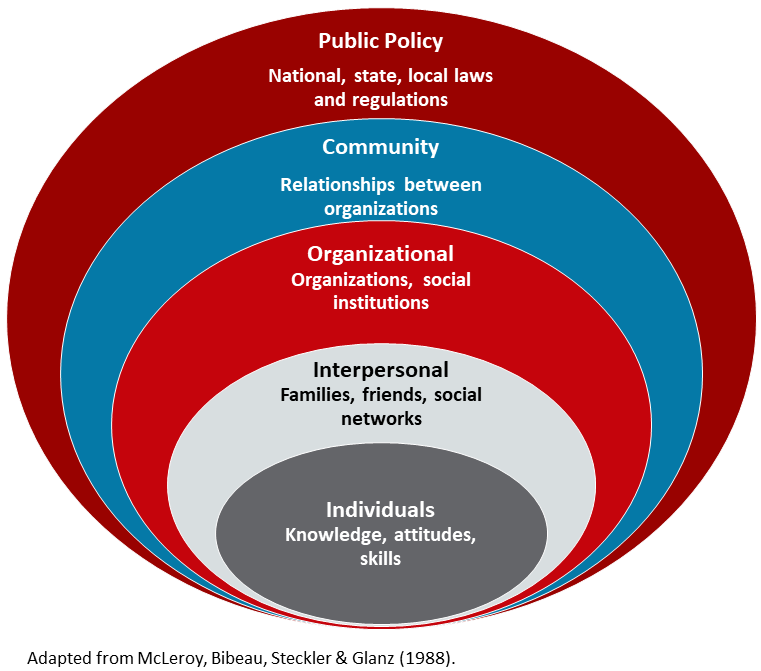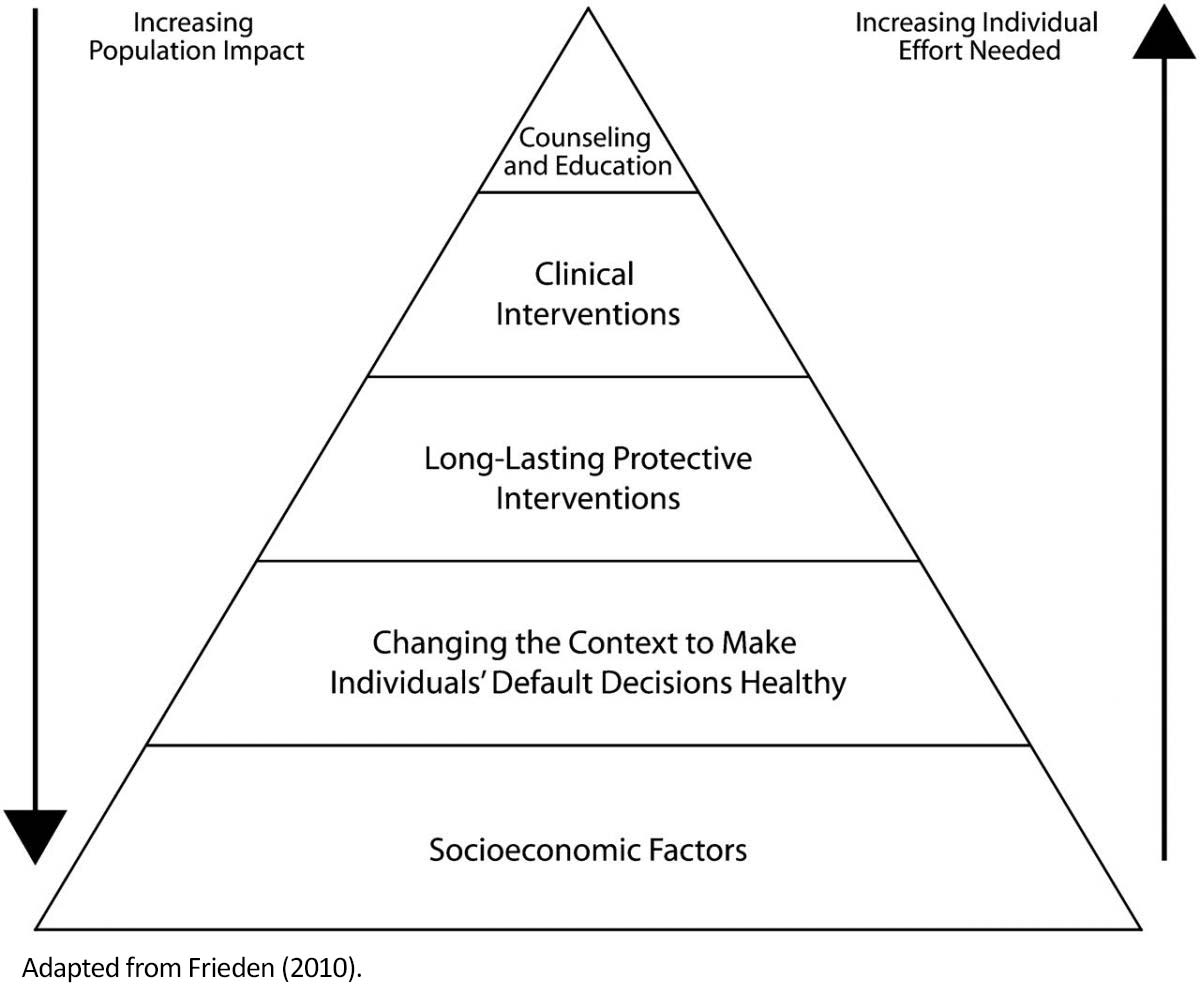Ideas for Taking Action
The Neighborhood Health Partnerships Program has developed curated lists of evidence-informed policies, programs, and system changes, based on the health measures in our Health Outcomes and Care Reports, to support you in selecting an action to improve the health of your neighborhood. Click on the images below to learn about tools on vaccination, screening, tobacco, diabetes, and heart disease.
Helpful Frameworks
Using a social determinants of health and health equity framework shows the many factors that impact health outcomes. This broader view of what drives health can expand our understanding of health-related issues and possible solutions.
Community priorities often align with the social determinants of health (commonly referred to as the SDoH). According to the World Health Organization (WHO), the social determinants of health are the “conditions in which people are born, grow, live, work and age.” These circumstances, which are shaped by the distribution of money, power, and resources, are mostly responsible for health inequities. Forming a complete picture of the health of a neighborhood requires recognizing: In the Bay Area Regional Health Inequities Initiative (BARHII) model, the social determinants of health can be shown as upstream causes (social inequities, institutional power, living conditions) that ultimately impact downstream outcomes (risk behaviors, disease and injury, mortality). The model presents the relationship between structural determinants of health, social determinants of health, health behaviors, and health outcomes. Using a model like BARHII can help you identify additional data needs and understand many of the factors that contribute to overall health in a neighborhood. For example, the NHP Health Outcomes and Care Reports provide health system and some sociodemographic data, but data on institutions (e.g. school, non-profits) are not available in the reports. Depending upon the health priority you are trying to address, you may want to seek out additional data to use in combination with NHP data reports. For additional considerations, see the Connecting to Other Data section. We used the social-ecological model to help us organize our action and intervention lists. The social-ecological model shows the complex relationship between an individual's health and the external environment. It is important to consider factors at each level of the model when considering the impacts on health and actions to take to improve health. The Health Impact Pyramid describes different types of interventions and which level of the pyramid they impact. Interventions increase in impact as you go down the pyramid. For example, an intervention that addresses socioeconomic factors has greater potential to improve health for larger numbers of people. Depending upon the health priority, some interventions and the level of the pyramid they impact may be more effective or appropriate depending on the context. Social Determinants of Health (SDoH)

Bay Area Regional Health Inequities Initiative (BARHII) Model

The Social-Ecological Model

The Health Impact Pyramid

Identifying Upstream Factors
Asking questions can also be a helpful way to get started. The answers may help you identify the upstream factors that contribute to neighborhood health. Some questions to consider include:
- Do all residents have a fair chance to make a livable wage?
- Do all residents have access to safe, affordable housing?
- Are all residents able to receive quality medical care? What barriers may be preventing this?
- Do all residents have convenient access to nutritious, affordable food options?
- Is there affordable and accessible public transportation in the neighborhood?
- Are there safe spaces for residents to exercise and be active?
- Are toxins like lead or other hazards present in this neighborhood that could lead to poor health?
- How have disease rates changed over time for this neighborhood? Are they the same or different from other neighborhoods?
- Have current or past policies reinforced systemic racism and/or income inequality in the neighborhood? Think across key sectors like business, education, and criminal justice.
- Do many residents in the neighborhood experience stress regularly, such as from discrimination based on their race, ethnicity, sex, sexual orientation, or country of origin?
- Do residents have dangerous jobs, such as roofing or steel work?
- Are there older residents without families nearby who might have issues with social isolation?
Connecting to Other Data

It is possible you are already using data to inform, prioritize, and plan your work and are wondering how NHP data and reports fit in. NHP data and reports can be used in conjunction with data you or your organization already have access to and work with to understand and provide more context on the health of the community.
Data can be used from multiple sources to better understand and meet the needs of the community. However, data users must be careful when using data sets where the measures use different populations, standards, and scale, so that they are not comparing apples and oranges, but using data to make valid inferences. One example of using two data sets might involve obtaining a Neighborhood Health Report on colorectal cancer screening rates for a ZIP code, and then using that report in combination with ZIP level data from the U.S. Census Bureau American Community Survey ZIP, looking at measures such as income (Sociodemographic Profile Report). Using these two data sources together provides an opportunity to analyze relationships between income and screening rates. Understanding this relationship could help users explore barriers to accessing screening.
When determining whether to use two data sources together, data users should ask:
- Are the populations the same for the different data sources?
- How do we use these datasets together, while also not making assumptions?
- Is there a benefit to connecting the datasets? Or is this more likely to cause harm?
To learn about other existing qualitative or quantitative datasets publicly available that complement NHP data, see the drop downs below.
Selecting an Intervention
There are many factors to consider when selecting an intervention for a neighborhood, such as:
- Population characteristics, needs, and values
- Organizational context and capacity
- Available evidence on effectiveness of interventions
- Resources available to support an intervention
- The type of impact that would be most useful to make (e.g., a direct impact on a health indicator, such as depression screening or an impact on the root causes of health inequities)
When different organizations are working together in a partnership to select an intervention to improve neighborhood health, each partner brings their own set of goals to the table. Selecting an action and/or intervention that helps to meet the goals of all parties will help build and strengthen partnerships. Click here for more information on building partnerships.
How to Use These Actions
The actions and interventions on the lists linked above are primarily neighborhood-level interventions that can largely be driven by community voice, neighborhood organizations, and partners. These lists are intended to help you start a conversation about addressing a need in your community. Note:
- Some interventions may require the cooperation of outside stakeholders (policy makers, health systems, public or private sector partners). Some of these actions and interventions might need to be modified in order to meet the unique needs and priorities of a neighborhood.
- It is possible that none of the actions and interventions on the lists are the exact fit for a particular neighborhood, but we hope that conversations help point the neighborhood towards the right action or intervention.
The interventions included in this tool are a starting point to consider. For more potential actions, please check out:
There are many researchers working on developing and evaluating interventions for specific health priorities who are interested in partnering with community organizations on projects. Connect with your NHP Navigator to see if there are any researchers working in your area of interest.
Creating a Plan
Once a neighborhood has selected an action or intervention to address the neighborhood health priority, they are ready to create a detailed plan that clearly describes the action or intervention and desired outcomes. The action plan is expressed in terms of goals, objectives, and activities with expected results. It includes a target date for each activity, a description of key resources needed, and establishes accountability. A carefully designed and well-written action plan also provides a solid basis for project evaluation.
Taking Action to the Next Level
Using Data and Reports to Take Action with Decision Makers
Policies have a tremendous impact on health inequities, even when they do not appear to directly deal with health or healthcare. Inequities continue to persist not only through initial policy decisions, but also through the policy’s legacy of resources, such as money, knowledge, or influence, that benefit people in positions of power. Policies can have ripple effects, positive and negative, in communities for generations and are important levers for change to address health inequities. Click here for more information on data in the policy making process and engaging with decision makers.
Examples of Using Reports for Action
To view examples of using NHP data and tools for action, view the Examples page.

